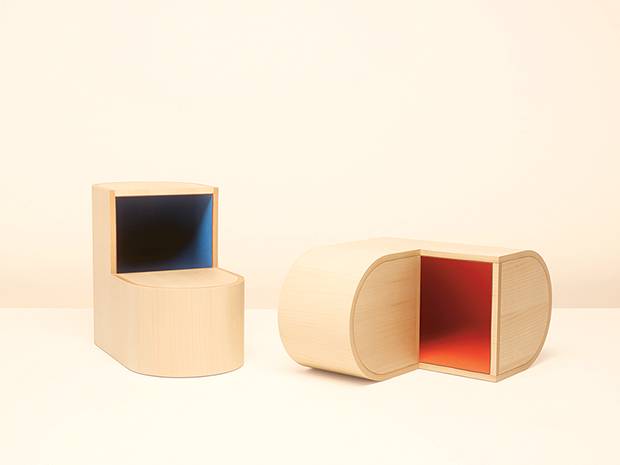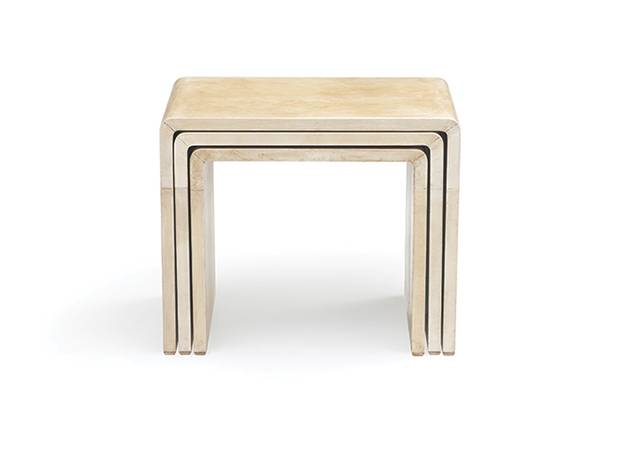The home of the Hermès Maison collections is found in Pantin, a working-class suburb northeast of Paris that has become increasingly populated with creative industries. Located mere blocks from where the Hermès leather atelier has been based since 1992, the airy showroom looks out onto low-rise buildings in brick and stone that are clearly not in the Haussmann style. The space instead conjures the feeling of an upscale loft somewhere further afield – East London, Brooklyn, or even a neighbourhood in Montreal. It makes for a compelling setup for the designers and decorators who visit the showroom to experience how such seemingly rarefied furniture, accessories and objets d'art can exist in everyday life.
Upon arrival, my raincoat is placed on a reissue of Paul Dupré-Lafon's Valet de Nuit, a recognizably handsome upright hanging system from the 1940s. When tea is offered, the lacquer serving tray it arrives on is set atop one of a cluster of Satellite tables, their marble and onyx patterning resembling planets or moons. The teapot and cups bear an Hermès motif subtle enough to appreciate with each sip.

Natural maple Équipages d’Hermès Sabot stools.
I am meeting Hélène Dubrule, the managing director of Hermès Maison and President of Puiforcat, the silver and fine flatware company that is operated by the luxury goods maker. She shows me around the space before we settle into the Sellier sofa with its cane screen sides, cinnamon-hued leather armrests, and toile cushions. Inconspicuously luxe, it was conceived by acclaimed Parisian designer Noé Duchaufour-Lawrance and presented at Salone del Mobile in Milan last year.
That international furniture fair is now as important a date on the Hermès Maison calendar as Paris Fashion Week is for the house's ready-to-wear collections, an occasion to present higher concept furniture designs (the core textiles and art de la table pieces usually roll out once or twice a year with less fanfare). At the most recent fair, Hermès presented a streamlined vanity tucked into a large cabinet stacked with shelves for storing silk scarves, as well as beautifully honed pale bamboo stools and benches by Pritzker Architecture Prize winner Alvaro Siza. Also on display were accessories accented with leather harness details including the standout Groom Attelé, an intricate hanging design developed in collaboration with Guillaume Delvigne and Damian O'Sullivan.

Cheval d’Arcons bench in Canaletto walnut and gold taurillon leather.
If you're wondering whether any of these pieces will be available when Hermès opens its new Toronto flagship on Nov. 29, the answer is yes – and whatever you don't see in store can be ordered. The brand has upwards of 300 stores around the world and in each customers will find some representation of homeware, whether the signature throw blankets or a leather change tray. The new Toronto maison – the largest Hermès store in Canada – will be among the roughly 40 locations that offer a more substantial selection of furniture.

Rééditions Jean-Michel Frank par Hermès Table à Cachette.
Customers who ascend the striking coiled staircase will discover the classic parchment nesting tables by Jean-Michel Frank reissued from the 1920s, along with the curvy Pippa folding chair, a mainstay piece credited to architect Rena Dumas with Peter Coles. Rena Dumas was the wife of the late CEO, Jean-Louis Dumas, a fifth-generation family member and until her death in 2009, she oversaw the design of Hermès stores. Their son, Pierre-Alexis Dumas has been the house's artistic director since 2011. In 2014, to enhance and fuel his vision of art du vivre (the art of living), he brought on Charlotte Macaux Perelman (an architect who worked for Philippe Starck, David Rockwell and André Balazs before starting her own firm, Studio CMP), and Alexis Fabry (an art book editor and curator specializing in photography) as deputy artistic directors for the Hermès home universe, as it is called. And indeed, the category is as expansive as it sounds, because beyond the obvious items, there are all the unexpected, almost anachronistic ones: a perpetual calendar; a magnifying glass tottering upon a leather cone; a leather icosahedron (an object with 20 triangular sides); spinning tops.

Rééditions Jean-Michel Frank par Hermès Inverted U-Nesting tables.
"Hermès has always been more than a house of objects, it's a house as a way of life – and I think Maison is the métier which embodies those values at their best," says Dubrule, who worked in both the company's fragrance and silk divisions before assuming the Maison role in 2009. As she explains it, these seemingly non-essential items have more essential resonance than ever. "Our lives are becoming more and more immaterial; there's a vanishing of objects. You will need some objects that will be effective [not because] they are useful but symbolic. I think we need to surround ourselves with some beauty," she says, noting how these objects provide a counterbalance to offset technology with material, or as she proclaims most dramatically: "Hermès brings warmth in a very cold world."
Incidentally, the blankets – or les plaids – might fulfill this need literally, especially the heavy wool, monogrammed ones made in Scotland that seem to be ever-present in shelter magazine photos. In the showroom, Dubrule encouraged me to touch a far more delicate style that had been hand-spun and hand-woven in Nepal; then she also unfolded one that used ikat dying to achieve a nuanced H; and finally, she revealed the pièce de resistance that boasted an illustration by artist Nigel Peake hand-embroidered with small pearlescent seed beads.

Collection Métiers chair in Canaletto walnut and taurillon leather.
The range of options suggests why the blankets and other small accessories already represent five to seven per cent of sales at the Toronto store. In the forthcoming flagship, however, customers will also, for the first time, be able to buy wallpapers and textiles, extending an identifiable Hermès presence throughout their homes. Jennifer Carter, president of Hermès Canada, says that the broader offering will allow people to fully visualize "a feeling and an atmosphere." While the pieces on display will be as easily purchasable as a bottle of perfume, she notes that the store will also be able to facilitate bespoke requests that range from the Cabriolet armchair in a custom colour (expect to wait around eight months for your version to arrive), to extraordinarily special orders through the Horizons department (think leather upholstery for helicopters and made-to-measure skateboards). In her mind, the space allocated to the home métier will underscore the playfulness and sophistication in equal measure. "With the furniture, you can really see the cleaner, functional side of Hermès," she says.
"It's luxurious without being ostentatious – and it can go with anything."
Which is what Dubrule suggests has been the ambition of Maison all along, from the Frank pieces that marked Hermès' foray into furniture in 1924 (Cole Porter and Nelson Rockefeller were among the French interior designer's clients) to the bronze table recently realized by Barber & Osgerby, its minimalist, barely glazed surface representing the epitome of pure design. She notes how the studio favours collaborating with architects because, unlike the typical fashion mindset, they "have a view of the long term."
Looking around the showroom, focusing first on a lamp, then a magazine rack, then the table set with Carnet d'Équateur china animated by the flora and fauna of artist Robert Dallet, it was remarkably clear how the pieces connected through their varying expressions of rigorous design and craftsmanship. Dubrule attributes this to feeling the "gesture of the person behind the object" within the design itself. The point, she says, is that the pieces are ever-changing yet timeless. "It's the idea of harmonious eclecticism," she offers. "Sometimes the object is useful; sometimes it's just for dreaming." And oftentimes, it's an expression of both.

Tie-Set plates.
Visit tgam.ca/newsletters to sign up for the Globe Style e-newsletter, your weekly digital guide to the players and trends influencing fashion, design and entertaining, plus shopping tips and inspiration for living well. And follow Globe Style on Instagram @globestyle.


